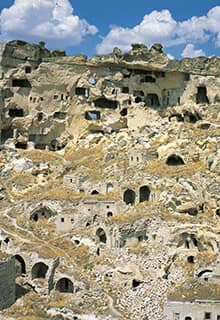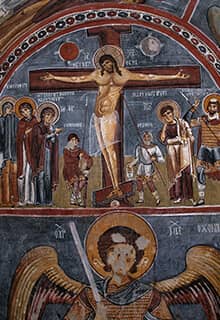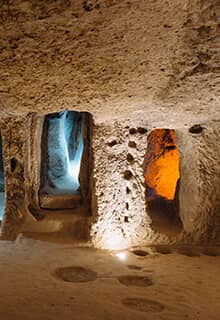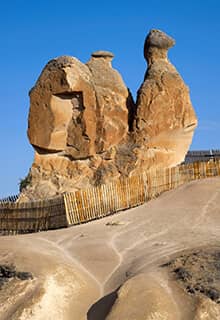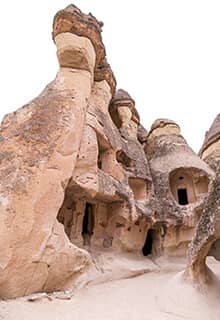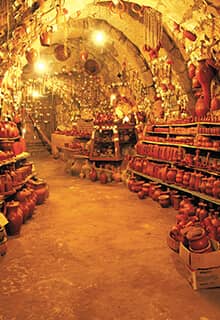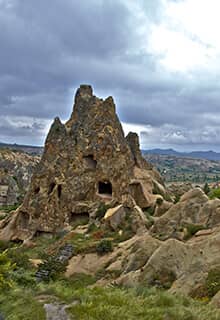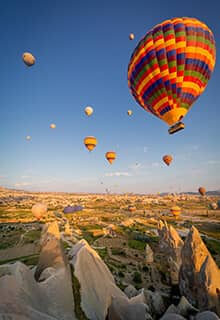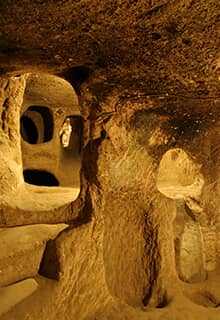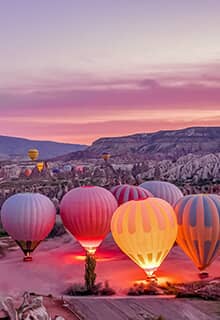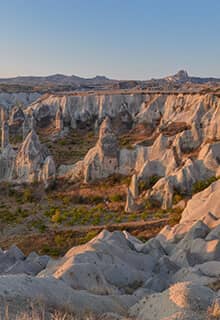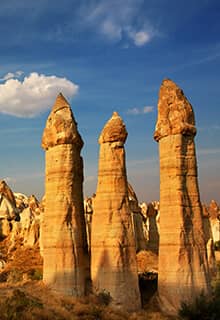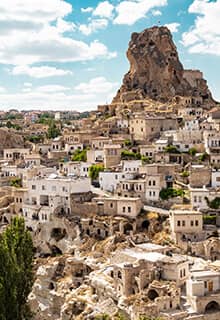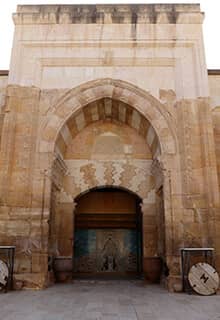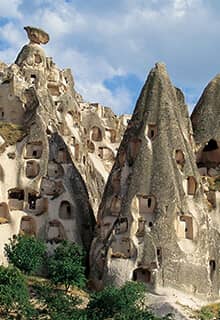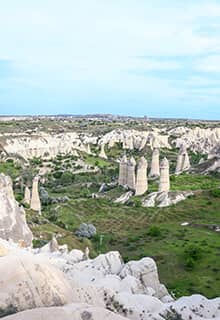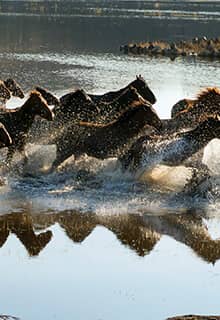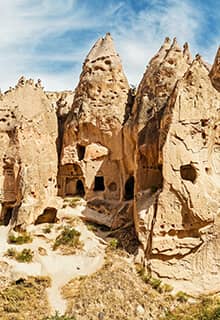

see
Cappadocia
Imagine waking up to a fairy tale landscape, with a brilliant sun rising into the bluest of skies. The same sky is which are peppered with hot air balloons slowly ascending. This is usually the first sight a visitor has when in Cappadocia, but this is just an introduction to the possibilities and adventures that await one in Cappadocia, the land of the beautiful horses.
Cappadocia incorporates parts of the cities of Aksaray, Nevşehir, Niğde, Kayseri and Kırşehir. For most people, the name Cappadocia suggests the towns of Uçhisar, Göreme, Avanos, Ürgüp, Derinkuyu, Kaymaklı and Ihlara, where the land has been shaped into fantastic forms over the course of millions of years. Fairy chimneys that seem mysterious and cities and houses of worship that extend many meters deep into the earth are all enveloped in an atmosphere that is ethereal and unworldly.
This very landscape has been home to innumerable cultures and civilizations, due to the ease with which the soil could be carved out. The area is littered with many underground cities that seem frozen in time. Cappadocia is an open-air museum that was witness and has evidence for the Assyrians, Hittites, Romans, Byzantines, Early Christians, Islam and more.
Göreme Open Air Museum
Listed as a UNESCO World Heritage site in 1985, Göreme casts its enigmatic charm for miles. The churches carved into these soft rocks sit still with mystery intact.
Göreme thought to have been used as a necropolis by the inhabitants of Venessa (Avanos) during Roman times. The churches of Durmuş Kadir, Yusuf Koç, El Nazar, Saklı, Meryem Ana (Virgin Mary) and Kılıçlar cast a spellbinding effect on visitors. The Göreme Open Air Museum is where the ideas of Christianity were unified by St Basil the Great and his brothers. The architectural details and frescoes of the Tokalı church, Convent of Monks and Nuns, Chapel of St Basil, and the St. Barbara, Elmalı, Yılanlı, Karanlık and Çarıklı churches seem as alive today as when they were new.
The captivating church interiors depict biblical scenes through detailed mural paintings alongside painted ornaments reaching to this day. One of the most important structures of the Göreme Open Air Museum is, without a doubt, the Dark (Karanlık) Church and Tokalı (Buckled) Church. As for the Tokalı Church, it has been built by an emperor, is striking with its decoration of imported lapis lazuli stone imported.
What makes it stand out is no other than its lively wall paintings. Dark (Karanlık) Church, dating back to the end of the 11th century and the beginning of the 12th century, its name derives from the very little light it receives from a small window in the narthex section. However, the lack of light has made this church keep its treasures alive, letting the frescoes resist the ruthless nature of time itself. Both the church and narthex carry vibrant and impressing depictions from the Bible. No wonder this church is at the top of the travelers’ lists…
Uçhisar
Imagine a gigantic, porous rock stretching towards the sky and now imagine you are standing on top of that said rock. If you are not in a plane, a balloon or a hawk, the best spot you will soak in the geography would be here, Uçhisar Castle. Uçhisar also has one of the most beautiful walking paths of Cappadocia going right through Pigeon Valley. You should wander through the tunnels opened up by the streams mighty flow, while listening to the pigeons flapping their wings as they leave their nest and saunter through the giant formations in the valley in awe, for knowing that they were sculpted by no one but the nature itself. Today, the castle is surrounded by shops and stalls, selling many souvenirs such as carpets, marble ornaments, mirrors and of course flavorsome dried nuts and fruits keeping you company.
Ürgüp
Moving from Göreme to the east, Ürgüp welcomes you to its ceaseless wonders. Aside of it being the largest settlement in Cappadocia, it is also a magnificent source for its immersive sights. These two elements combined bring out one of the most unique pictures there is: an Anatolian town bursting with hotels, restaurants, and shops, and right by its side lay cave dwellings. The stone mansions placed on these very rocks are known to be the trademark of this region. Besides its detailed mystic found every corner, Ürgüp is also the place to break loose and shake the worries away it is where you will find the best night life in Cappadocia.
Mustafapaşa Village (Sinassos)
Mustafapaşa, located 6 km to the south of Ürgüp, is a hidden town with both architectural and cultural surprises. Large numbers of Greek Christians, (known locally as Rûm) lived in Cappadocia peacefully alongside their Muslim neighbours for generations…One such is Mustafapaşa, formerly known as Sinasos, today a peaceful little town off the main tourist trail... Attractive mansions (konak) display fine examples of stonework, hidden behind statuesque neo-classical façades. A short stroll among them takes one back in time to simpler foundations.
The minaret of a 17th-century Seljuk mosque looms over one of the town's two squares, while later attractions, including the Ottoman-era Şakir Paşa Madrasa and the impressive late 19th-century Church of Constantine and Helen, are both located prominently in the center of town.
The Gomeda valley, to the west of Mustafapaşa, is one of the sanctuaries where early Christians flocked to between the first and 11th centuries for. It is similar to the Ilhara valley, though smaller. The walls of the valley are peppered with residences, churches and shelters from days long gone, hewn into the live rock. The view from them of the river that snakes through the valley is worth the visit.
Ortahisar
Ortahisar, 6 km away from Ürgüp, is home to the once strategically important Ortahisar citadel, a must-see place with fine examples of Cappadocia's vernacular architecture, clustered around its base. Another must-see sight is the Üzümlü Church on the western side. Ortahisar Castle is considered one of the first multi-story settlements in the world, making it a unique architectural curiosity. The structure, which provided shelter for the historical Silk Road caravans during the Hittite period, is actually a giant fairy chimney in disguise. Being one of the highest spots in the region today. Visiting this castle guarantees a teleport to the ancient times.
The sides of the valleys are littered with carved out storage areas used for preserving local products such as apples and potatoes, as well as oranges and lemons brought in from the Mediterranean. Very interesting churches and monasteries can be found in the surrounding valleys. Among these are Sarıca Church, Cambazlı Church, Tavşanlı Church, Balkan Deresi Churches and Hallaç Deresi Monastery.
Avanos
Its unusual livelihood is what makes Avanos (Vanessa) intriguing. As the Kızılırmak has made its way flowing patiently through Avanos, the soft and oily clay sourced from the former riverbeds have been the highlight here –making Avanos the home of pottery dating way back to the Hittites. Each individual flaw in clay brings out the authentic beauty in these handmade pieces, then colored in earthy tones and of course turquoise. You can always join a pottery workshop and create your own “happy accident”, shop goodies in lively bazaars and lighten your mood by the riverside.
Red Valley (Kızıl Vadi)
Every other spot here serves the best dreamy sunset, but one sets itself apart from every other: Red Valley. Located just near Çavuşin Village and Ortahisar, Red Valley draws the most romantic and unforgettable moments as the sky takes on crimson red tones. Visitors are encouraged to start their walk through the rare formations red tuff creates just before sunset and take their place at the viewing terrace just at the right moment, to soak in the glamour.
Çavuşin
Your next destination may not radiate its allure from afar but once in, you will leave in awe for sure. Çavuşin village lies within minutes from Göreme. Once you are through this seemingly ordinary village, your path will take you to ancient ruins and fairy chimneys making their way to the village square. If you wish to further explore the ruins, just follow the tracks and you will find yourself in an area famous for its churches and clergy houses. You can access the oldest churches, built between 1st and 10th centuries, through this path. Extending your walk half an hour, you can reach the churches in Güllüdere and Kızılçukur though the most enticing site inviting you just near the slope of a cliff: one of the oldest and the largest in Cappadocia, the Church of St John the Baptist.
Paşabağ (Monk’s Vineyard)
Paşabağı, also known as Monk’s Vineyard is situated about 1 km off the Göreme-Avanos road to Zelve. Several fairy chimneys with multiple stems and caps, some housing chapels unique to this area and living areas can be found here in this magic land. The capped fairy chimneys here have a conical body, made of tuff and volcanic ash. The hat part consists of hard rocks, so the rock type forming the hat is more durable than the rock group foming the body. This is the primary reason for how the fairy chimneys were formed.
Here in Paşabağ, a chapel dedicated to St. Simeon, and a hermit's shelter is built into one such fairy chimney with three heads. The entrance of the cell, which can be reached with a chimney-like narrow tunnel is decorated with crosses. They hollowed out the chimneys from top to bottom, creating rooms 10-15 m high. They slept on beds made from rock, and were fed by locals via buckets on ropes lowered down from their lofty perches.
Zelve
Consisting of three valleys, Zelve has the most intensity in terms of fairy chimneys. If you want to examine the beauties of nature, you should start trekking early in the morning. The important churches in the valley are Balıklı and Üzümlü all hauntingly captivating, illustrating the ancient monastic life.
Devrent
The “Three Beauties” fairy chimneys, one of the symbols of Cappadocia, which offers its guests fabulous views with its natural, historical and cultural richness, is one of the most visited spots in the central Anatolian region.
Consisting of three adjacent fairy chimneys defined as father, mother and child in Cappadocia’s Ürgüp district in the central Anatolian province of Nevşehir, the “Three Beauties” attracts the attention of tourists at all times of the year.
Gülşehir
Located 20 km northwest to Nevşehir and south of Kızılırmak (Red River), Gülşehir was named as “Zoropassos” in ancient times and “Arapsun” after Seljuks. Açıksaray Ruins, 3km to Gülşehir, an important episcopal center with its Roman Period rock tombs carved into tuff rocks and its rock churches dating back to the 9th-10th centuries. The mushroom rock formations, which are the symbol of Gülşehir, are also located here in this region. Boğalı Church, a monastery, with multi-storey underground cities and caves from ancient times, Backgammon (Horse Roof), Small Palace (Multi-Storey Settlement Area), Four Column Monastery, Cradle Vaulted Building, Twelve Columned Church and Staircase Residence are must-see places. Açıksaray Ruins is mostly preferred for trekking lately. It is a cultural and sports center too with its 7 km long track, which also includes the Çat Valley.
Underground Cities
Derinkuyu
Located in the Derinkuyu district in Nevşehir, Derinkuyu Underground City is one of the best places that all tourists would definitely like to visit. It was used for locals for centuries to hide from persecution or attacks. The depth of Derinkuyu underground city is approximately 85 meters. This mysterious underground place has all the features found in an underground city as in barns, cellars, refectory, churches, boileries etc. In addition, there is a missionary school on the 2nd floor. The ceiling of the school is covered with a barrel vault, not common in underground cities. The spaces to the left of the hall are the study rooms. After the 3rd and 4th floors of the underground city, the staircase descends in depth and the cross-planned church on the ground floor is reached. Each floor cannot benefit from the wells and ventilation shafts extending to the lower floor, and in order to prevent poisoning during any invasion, tops of some wells are concealed from the upper ground level. Only ten percent of the Derinkuyu Underground City, that was opened in 1965, can still be visited.
Kaymaklı
South of Nevşehir, the road takes you to the underground cities of Kaymakli and Derinkuyu respectively. Situated deep below Kaymaklı Castle, Kaymaklı underground city features a maze of tunnels and rooms carved eight levels deep into the earth. The first floor was used as a stable, while the other levels include living quarters, a church and even graves. The people of Kaymaklı village constructed their houses around nearly one hundred tunnels of the underground city. While it consists of 8 levels below ground, only four of them can actually be visited.
Özkonak
The underground city Özkonak is located 14 km away from Avanos. It was built on the northern slopes of İdiş Mountain, where volcanic granite-made tuff layers are quite dense. The galleries spread over a wide area and are connected to each other by tunnels.
Unlike Derinkuyu and Kaymaklı underground cities, there are very narrow and long ducts for communication between floors. When the entrances of the neatly carved rooms are closed, ventilation is provided by narrow (5cm.) long chimneys. Again, unlike other underground cities, ducts were carved in the tunnel walls, presumably to pour hot oil on any pursuing enemy, around the sealed and secured bolt stones. In Özkonak underground city, there are air chimneys, water wells, fountains and bolt stones as in Kaymaklı and Derinkuyu.
Mazı
Mazı village, with its ancient name "Mataza", is located 18km south to Ürgüp, east of Kaymaklı Underground City. Here in Mazı underground city 4 separate entrances were found, the main one is through a corridor made of irregular stones. The large bolt stone in the short corridor ensures the entrance and exit of the underground city is secure. The small area in the interior is made to facilitate the easy sliding of the bolt stone. The church of the underground city is reached through a short corridor from the stables. The entrance of this place can be closed with another bolt stone. Unlike the church in Kaymaklı Underground City, here in Mazı the church apse was carved on the long side corner and its facades were decorated with reliefs. Although the renovation is not complete, you can still experience the mysterious atmosphere of what it must have been like to live here and admire the ingenious ventilation system.
Tatlarin
Tatlarin town, located 10 km north to Acıgöl district, is another mesmerizing place in Cappadocia, with its underground city and churches and residential architecture. It is situated on the slope of the hill called "Castle". The narthex of the church, which has two naves, two apses and a barrel vault, has collapsed. The scenes in the well-preserved frescoes are separated from each other. Dark gray is used on the floor, and purple, mustard and red colors are used in the depictions. The underground city, which was opened to visitors in 1991, brings to mind a military garrison or monastery complex due to the size of its venues, the number of food stores and the abundance of churches. The most important feature of the underground city, which can still be visited on two floors, is that it has a toilet that cannot be found in other underground cities.
Ihlara Valley
If you wish to travel beyond time and explore a world you have never stepped foot on before, Ihlara Valley is the place you are in search for. It is known that the 14-kilometer-long valley has been an important religious center since the days Christianity has been founded, shining light on the numerous churches and historical living spaces scattered all around. Here, the frescoed churches formed by the geological features of the region are carved into the rocks in accordance with the spirit of the monastery. If you wish to visit the architecture and wander inside the mesmerizing designs, you are in luck. 14 of these churches are open for exploration: Ağaçaltı, Sümbüllü, Yılanlı, Kokar, Prenliseki, Eğritaş, Direkli, Saint Georgeus, Karagedik, Ala, Bezirhane, Bahattin Samanlığı and Batkın Churches. Better gear up before starting your valley walk for this descending 382 step ladder can take up to four hours. Don’t let the timing discourage you either: gazebos built on the Melendiz Stream will allow you to take breaks and rinse your journey down with a cup of tea.
Selime Monastery
Selime Cathedral is the largest one in Cappadocia, built on two floors, dating back to the VIII. and IX. centuries. In the cathedral, there are depictions such as the ascension of Christ and Mary. At the exit to Selime cathedral and monastery, we encounter a high corridor, which is part of the caravan route through which camels were taken. Because of the market set up in Selime, caravans would come here and camels were taken to the central part of the cathedral for safety. The whole complex was built to facilitate those who want to rest and worship. One of the most important features of Selime Monastery is that it is the place where the clergy in the region were trained. In addition, the first loud ritual was held in Selime Cathedral. The structures made by carving the rocks and most of them, as churches, bear the traces of Byzantine art. It is also noteworthy that the upper part of the cathedral was built as a castle.
Hacı Bektaş-ı Veli
With Islam's arrival in Anatolia, it became the home of several famous Muslim scholars and philosophers. At the end of the 13th century the Turkish and Muslim mystic Hacı Bektaş-ı Veli, known as Hacıbektaş today, settled at Anatolia. The core tenets of this sage's philosophy, crucial to achieving unity among the different Turkish groups in Anatolia, embody the spirit and substance of the 1948 Universal Declaration of Human Rights. The town of Hacıbektaş, 45km from Nevşehir, has a 14th-century mosque complex that includes the tomb of Hacı Bektaş-ı Veli, a mosque, guesthouse, kitchen, wishing tree and an area for ascetics. The complex, which is now a museum, has been inscribed in the Tentative List of UNESCO's World Heritage.

